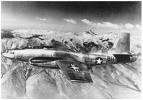
|
John A. Weeks III
Sunday, December 14, 2025, 7:04:12 PM CST |
|||
| Home | Photo Tours | Rail Fan | 12 Easy Steps |
| Aviation | Spacecraft | Highways & Bridges | About The Author |

|
|
|||||||||||||||||
B-45 — The Tornado Survivors
The US Army Air Force was very impressed with the performance of the new
German Arado 234 jet bomber. The Ar-234 was faster than most of the
allied fighter aircraft, and it proved to be nearly impossible to
intercept when flying a bombing mission. The USAAF decided that it had
to obtain both short range jet bombers in case WWII lingered on, as well
as longer range jet bombers to use in the Pacific against Japan. Requirements
were issued for the so called "Class of 45" bombers. The two short range
bombers would be the North American B-45 and the Convair B-46, while the
larger long range bombers would be the Boeing B-47 and the Martin B-48.
Three of the four members of the class of 45 would be conventional straight wing aircraft, while the B-47 would use captured German test data. This gave the B-47 a huge advantage. Like the B-47, the B-48 would be a six-engine heavy bomber. But hampered by the straight wing and an engine configuration that did not operate they way it was predicated based on wind tunnel testing, the B-48 dropped out of the race fairly quickly. The USAAF knew that the future was the B-47, but it would be several years before the B-47 was available. Meanwhile, the B-45 was quickly outclassing the B-46 in testing, so the B-46 was dropped, and the B-45 was put into production as a critical stop-gap until the B-47 was ready.




The production order for the B-45 Tornado was 190 aircraft. There were 3 XB-45, 96 B-45A, 10 B-45C, and 33 RB-45C recon variants built for a total of 142 aircraft. Initial use of the B-45 proved that it was a relatively poor bombing aircraft. The USAF wanted to deploy the B-45 to the far east, but found that it had too short of range to reach Hawaii, yet was too big to go by ship. At this point in time, it looked like the B-45 might end up being used strictly for training and transition. At that point, world affairs intervened. The Korean war proved that the B-29 was no longer able to match with the new jet interceptors such as the Soviet MiG-15. That meant that B-29 aircraft sitting on nuclear alert in Europe were likely to not be able to carry out their mission. A decision was made to convert the B-45A to be nuclear capable. This was no small feat considering the amount of electronics needed to deliver a nuclear weapon, and the large variety of nuclear weapons in the inventory. But from May of 1952 until July of 1958, the B-45 stood front line duty as the nuclear arm of the USAF in Europe. While the B-45 was far from ideal, and its limited range meant it would be a one way mission, the B-45 was all we had until the B-47 came on-line. The final production run of B-45 was the C model. These were mostly built as camera ships to be used for photo reconnaissance missions. A key mission was bomb damage assessment following conventional bombing strikes. The RB-45C could carry four different types of cameras. It proved to be an excellent photo recon aircraft. Recently declassified documents show that the RB-45C was used for deep penetration missions into the Soviet Union by both USAF and RAF crews during the mid-1950s. While the B-45 had an awkward beginning and served for only a short period of time, it still managed to rack up a list of Air Force firsts. This included the first 4-engine jet bomber, first air-to-air refueling of a jet aircraft, and the first jet bomber to stand nuclear alert. The photo recon version paved the way for future dedicated recon aircraft such as the U-2 and SR-71. B-45 Tornados On Static Display
Note—click on the Serial Number to see a photo of each airplane.
|
|
|
Authored by John A. Weeks III, Copyright © 1996—2016, all rights reserved. For further information, contact: john@johnweeks.com
|